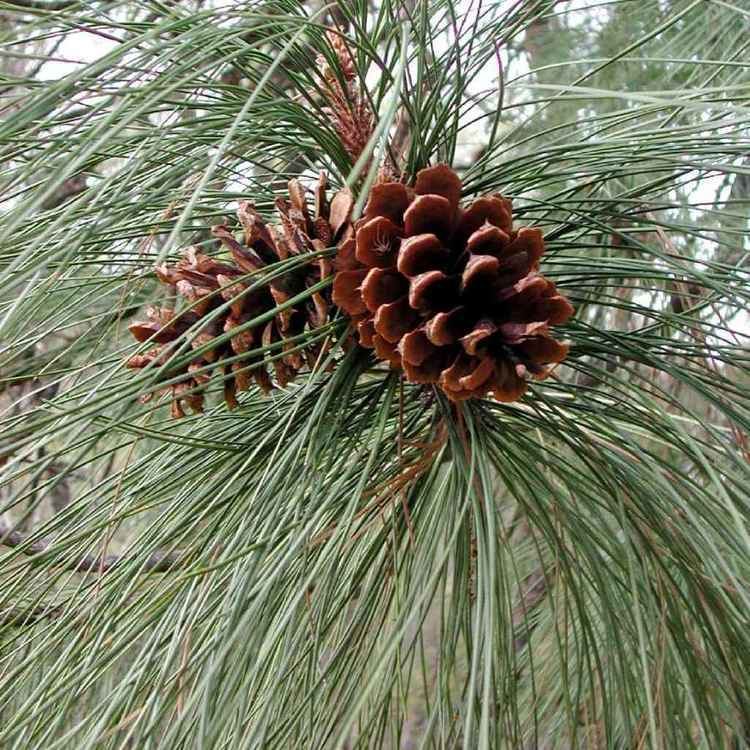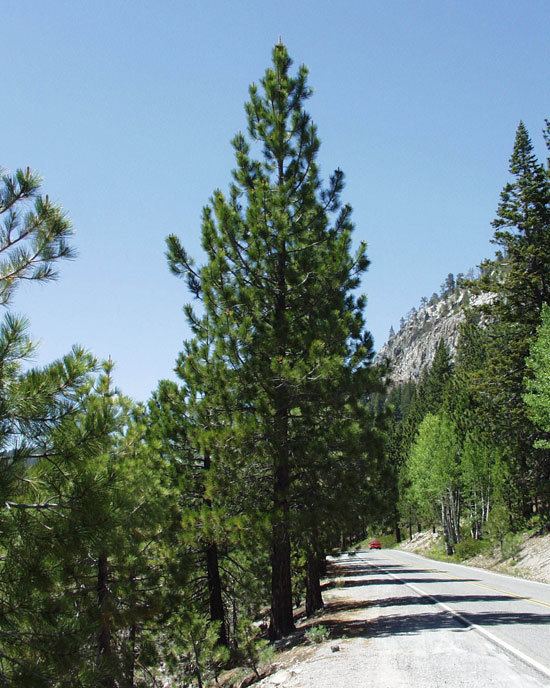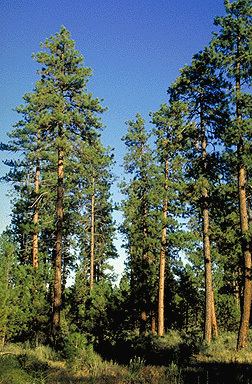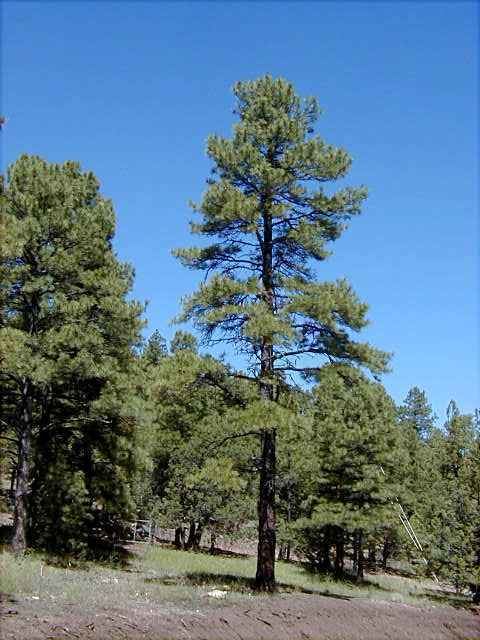Kingdom Plantae Class Pinopsida Family Pinaceae Scientific name Pinus ponderosa Symbol of Montana | Division Pinophyta Order Pinales Genus Pinus Rank Species | |
 | ||
Similar Pinus contorta, Douglas fir, Pseudotsuga, Abies concolor, Eastern white pine | ||
Ponderosa pine pinus ponderosa
Pinus ponderosa, commonly known as the ponderosa pine, bull pine, blackjack pine, or western yellow-pine, is a very large pine tree species of variable habitat native to the western United States and Canada. It is the most widely distributed pine species in North America.
Contents
- Ponderosa pine pinus ponderosa
- Pinus ponderosa ponderosa pine
- Description
- Size
- Cultivation
- Use in nuclear testing
- Ecology and distribution
- Taxonomy
- Subspecies and varieties
- Distinguishing subspecies
- References

It grows in various erect forms from British Columbia southward and eastward through 16 western U.S. states and has been successfully introduced in temperate regions of Europe. It was first documented into modern science in 1826 in eastern Washington near present-day Spokane (of which it is the official city tree). On that occasion, David Douglas misidentified it as Pinus resinosa (red pine). In 1829, Douglas concluded that he had a new pine among his specimens and coined the name Pinus ponderosa for its heavy wood. In 1836, it was formally named and described by Charles Lawson, a Scottish nurseryman. It is the official state tree of Montana.

Pinus ponderosa ponderosa pine
Description

Pinus ponderosa is a large coniferous pine (evergreen) tree. The bark helps to distinguish it from other species. Mature to over-mature individuals have yellow to orange-red bark in broad to very broad plates with black crevices. Younger trees have blackish-brown bark, referred to as "blackjacks" by early loggers. Ponderosa pine's five subspecies, as classified by some botanists, can be identified by their characteristically bright, green needles (contrasting with blue-green needles that distinguish Jeffrey pine). The Pacific subspecies has the longest—19.8 cm or 7.8 in—and most flexible needles in plume-like fascicles of three. The Columbia ponderosa pine has long—12.0–20.5 cm or 4.7–8.1 in—and relatively flexible needles in fascicles of three. The Rocky Mountains subspecies has shorter—9.2–14.4 cm or 3.6–5.7 in—and stout needles growing in scopulate (bushy, tuft-like) fascicles of two or three. The southwestern subspecies has 11.2–19.8 cm or 4.4–7.8 in, stout needles in fascicles of three (averaging 69–89 mm (2.7–3.5 in)). The central High Plains subspecies is characterized by the fewest needles (1.4 per whorl, on average); stout, upright branches at narrow angles from the trunk; and long green needles—14.8–17.9 cm or 5.8–7.0 in—extending farthest along the branch, resembling a fox tail. Needles are widest, stoutest, and fewest (averaging 56–71 mm (2.2–2.8 in)) for the species.

Sources differ on the scent of P. ponderosa, but it is more or less of turpentine, reflecting the dominance of terpenes (alpha- and beta-pinenes, and delta-3-carene). Some state that it has no distinctive scent.
Size

The National Register of Big Trees lists a ponderosa pine that is 235 ft (72 m) tall and 324 in (820 cm) in circumference. In January 2011, a Pacific ponderosa pine in the Rogue River–Siskiyou National Forest in Oregon was measured with a laser to be 268.35 ft (81.79 m) high. The measurement was performed by Michael Taylor and Mario Vaden, a professional arborist from Oregon. The tree was climbed on October 13, 2011, by Ascending The Giants (a tree-climbing company in Portland, Oregon) and directly measured with tape-line at 268.29 ft (81.77 m) high. This is the second tallest known pine after the sugar pine.
Cultivation
This species is grown as an ornamental plant in parks and large gardens.
Use in nuclear testing

During Operation Upshot–Knothole in 1953, a nuclear test was performed in which 145 ponderosa pines were cut down by the United States Forest Service and transported to Area 5 of the Nevada Test Site, where they were planted into the ground and exposed to a nuclear blast to see what the blast wave would do to a forest. The trees were partially burned and blown over.
Ecology and distribution

Pinus ponderosa is a dominant tree in the Kuchler plant association, the ponderosa shrub forest. Like most western pines, the ponderosa generally is associated with mountainous topography. However, it is found on banks of the Niobrara River in Nebraska. Scattered stands occur in the Willamette Valley of Oregon and in the Okanagan Valley and Puget Sound areas of Washington and British Columbia. Ponderosa covers 1,000,000 acres (400,000 ha), or 80%, of the Black Hills of South Dakota. It is found on foothills and mid-height peaks of the northern, central, and southern Rocky Mountains, in the Cascade Range, in the Sierra Nevada, and in the maritime-influenced Coast Range. In Arizona, it predominates on the Mogollon Rim and is scattered on the Mogollon Plateau and on mid-height peaks in Arizona and New Mexico. It does not extend into Mexico.
The fire cycle for ponderosa pine is 5 to 10 years, in which a natural ignition sparks a low-intensity fire.
Pinus ponderosa needles are the only known food of the caterpillars of the gelechiid moth Chionodes retiniella. Blue stain fungus, Grosmannia clavigera, is introduced in sapwood of P. ponderosa from the galleries of all species in the genus Dendroctonus (Mountain Pine Beetle), which has caused much damage.
Taxonomy
Modern forestry research has identified five different taxa of P. ponderosa, with differing botanical characters and adaptations to different climatic conditions. Four of these have been termed "geographic races" in forestry literature. Some botanists historically treated some races as distinct species. In modern botanical usage, they best match the rank of subspecies and have been formally published.
Subspecies and varieties
- Pinus ponderosa subsp. brachyptera Engelm. — southwestern ponderosa pine.
- Pinus ponderosa subsp. critchfieldiana Robert Z. Callaham subsp. novo — Pacific ponderosa pine.
- Pinus ponderosa var. pacifica J.R. Haller & Vivrette — Pacific ponderosa pine.
- Pinus ponderosa subsp. ponderosa Douglas ex C. Lawson — Columbia ponderosa pine, North plateau ponderosa pine.
- Pinus ponderosa subsp. readiana Robert Z. Callaham subsp. novo — central High Plains ponderosa pine.
- Pinus ponderosa var. scopulorum (Engelm. in S.Watson) E. Murray, Kalmia 12:23, 1982 — Rocky Mountains ponderosa pine.
- Pinus ponderosa var. washoensis (H. Mason & Stockw.) J.R. Haller & Vivrette — Washoe pine.
Distributions of the subspecies in the United States are shown in shadow on the map. Distribution of ponderosa pine is from Critchfield and Little. The closely related five-needled Arizona pine (Pinus arizonica) extends southward into Mexico.
Before the distinctions between the North Plateau race and the Pacific race were fully documented, most botanists assumed that ponderosa pines in both areas were the same. When a botanist and a geneticist from California found in 1948 a distinct tree on Mt. Rose in western Nevada with some marked differences from the ponderosa pine they knew in California, they described it as a new species, Washoe pine Pinus washoensis. Subsequent research determined this to be one of the southern-most outliers of the typical North Plateau race of ponderosa pine. Its current classification is Pinus ponderosa var. washoensis.
An additional variety, tentatively named P. p. var. willamettensis, found in the Willamette Valley in western Oregon, is rare. This is likely just one of the many islands of Pacific subspecies of ponderosa pine occurring in the Willamette Valley and extending north to the southeast end of Puget Sound in Washington.
Distinguishing subspecies
The subspecies of P. ponderosa can be distinguished by measurements along several dimensions:
Notes
Names of taxa and transition zones are on the map.
Numbers in columns were derived from multiple measurements of samples taken from 10 (infrequently fewer) trees on a varying number of geographically dispersed plots.
Numbers in each cell show calculated mean ± standard error and number of plots.
